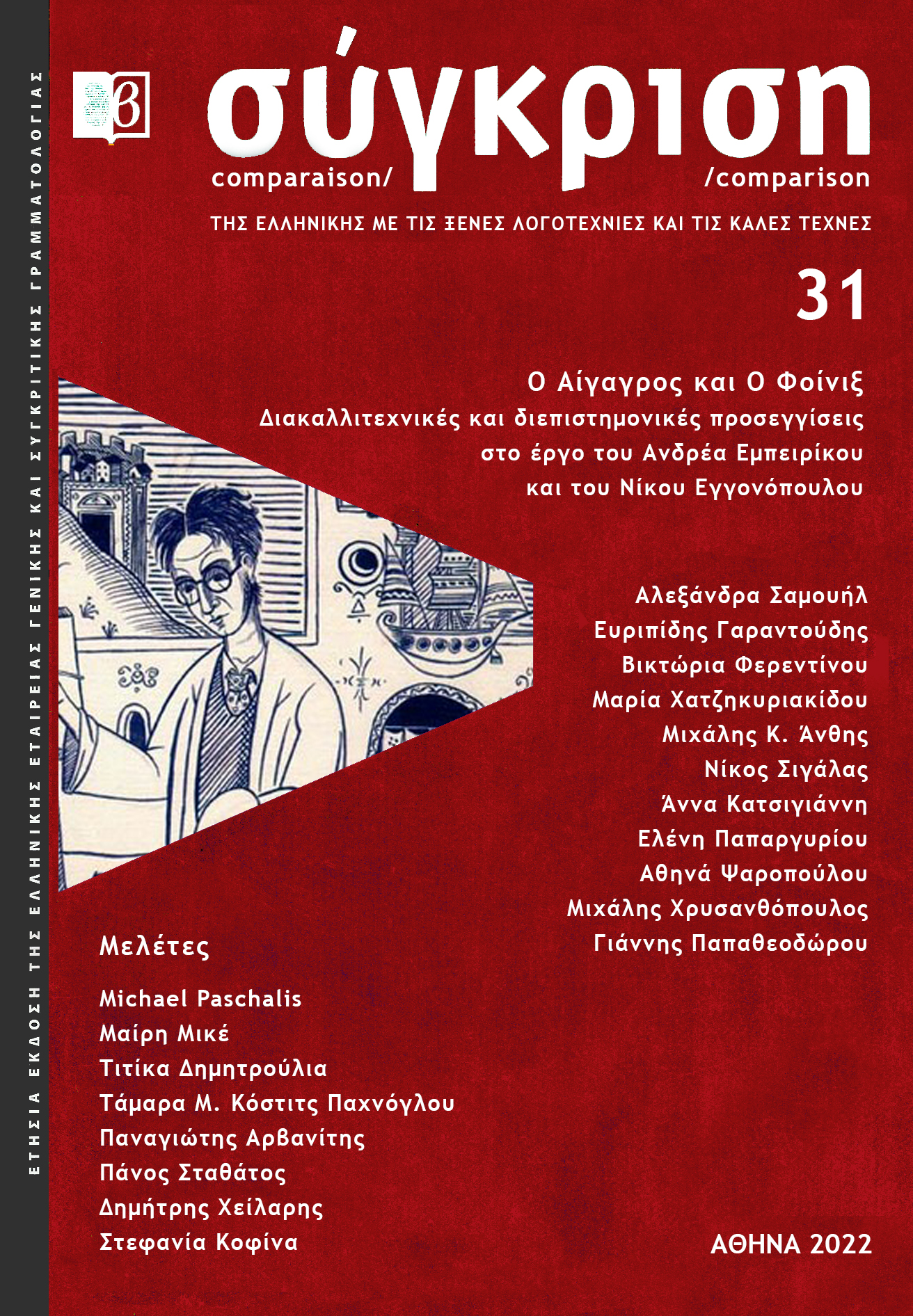ΒΙΚΤΩΡΙΑ ΦΕΡΕΝΤΙΝΟΥ, Τα συγκοινωνούντα δοχεία μιας υβριδικής ποιητικής: Ο μύθος ως διακαλλιτεχνική και διαπολιτισμική ώσμωση στο έργο του Νίκου Εγγονόπουλου
Περίληψη
The Communicating Vessels of a Hybrid Poetics: Myth as Intermedial and Intercultural Osmosis in the Oeuvre of Nikos Engonopoulos
In 1938, the year of the International Exhibition of Surrealism at the Gallery Beaux-Arts in Paris, the poet and painter Nikos Engonopoulos created Birth of Orpheus and Genesis of Myth. The depiction of the birth of young Orpheus as emblematic of the construction of myth recalls the mythopoetic process as articulated in the anthology of the poet, psychoanalyst and photographer Andreas Embeirikos, Writings or Personal Mythology (1936-1946): “Each myth’s becoming is a child who grows up.” This reception of myth should be situated in the context of the French surrealists’ endeavour to formulate a new collective mythology that would respond to the political and social environment of the interwar years. This collective mythology resorted to cultural topoi that were deemed countercultural, marginalised or anti-Enlightenment, ranging from primitive, prehistoric and Gothic art to magic, alchemy and mythological traditions of archaic or non-European cultures. In this framework, surrealist myth was reconfigured as a new poetic language in constant metamorphosis that could articulate through diverse media and cultural traditions the surrealist vision for the radical transformation of the world.
In Greece the appropriations of classical myth were central to the modernist canon. However, the Greek surrealists transformed myth in subversive ways initiating a dialogue with the present in the light of anthropology, ethnography, history of religions and psychoanalysis. Recent research has shown that Embeirikos and Engonopoulos conversed with French Surrealism and their colleagues’ engagement with alternative epistemologies and comparative religion and mythology, participating to a fecund renegotiation of the past. This paper aims at contributing to the revision of the history of Surrealism in Greece by exploring the function of myth, both as intermedial language and discursive practice, in Engonopoulos’s work. Most specifically, it purports to investigate the poetic anthologies Do not Speak to the Driver (1938) and The Clavichords of Silence (1939) alongside visual works he created at the end of the 1930s, such as the drawing SO4H2 (1937), and the engraving Vierge inviolable, métaphysique et surréaliste-sonore (1930s). The subtitles given initially to the aforementioned anthologies allude to the comparison of the arts and the equation of poetry and painting in an alchemical fusion pursued by the historical avant-gardes and Surrealism. Engonopoulos’s work and his experimentations with image-making should be revisited within this context and seen as a paradigm of the formulation of a new myth that sought to interweave the visual arts, poetry and alternative epistemologies into a revolutionary, hybrid form of expression that could effect the individual and society.
Λεπτομέρειες άρθρου
- Πώς να δημιουργήσετε Αναφορές
-
Φερεντίνου Β. (2022). ΒΙΚΤΩΡΙΑ ΦΕΡΕΝΤΙΝΟΥ, Τα συγκοινωνούντα δοχεία μιας υβριδικής ποιητικής: Ο μύθος ως διακαλλιτεχνική και διαπολιτισμική ώσμωση στο έργο του Νίκου Εγγονόπουλου. Σύγκριση/Comparaison/Comparison, 31, 28–41. https://doi.org/10.12681/comparison.31272
- Τεύχος
- Τόμ. 31 (2022)
- Ενότητα
- Άρθρα

Αυτή η εργασία είναι αδειοδοτημένη υπό το CC Αναφορά Δημιουργού – Μη Εμπορική Χρήση – Παρόμοια Διανομή 4.0.
Οι συγγραφείς των άρθρων που δημοσιεύονται στο περιοδικό Σύγκριση διατηρούν τα δικαιώματα πνευματικής ιδιοκτησίας επί των άρθρων τους, δίνοντας στο περιοδικό το δικαίωμα της πρώτης δημοσίευσης. Άρθρα που δημοσιεύονται στο περιοδικό Σύγκριση διατίθενται με άδεια Creative Commons 4.0 και σύμφωνα με την άδεια μπορούν να χρησιμοποιούνται ελεύθερα, με αναφορά στο/στη συγγραφέα και στην πρώτη δημοσίευση για μη κερδοσκοπικούς σκοπούς και με δικαίωμα τροποποίησης μόνον με παρόμοια διανομή (αν αναμείξετε, τροποποιήσετε, ή δημιουργήσετε πάνω στο υλικό, πρέπει να διανείμετε τις δικές σας συνεισφορές υπό την ίδια άδεια όπως και το πρωτότυπο).



